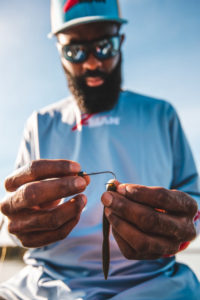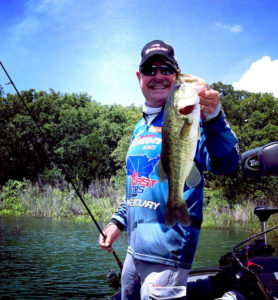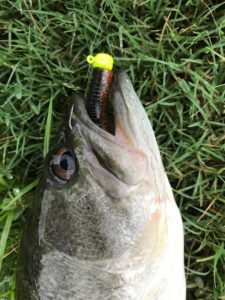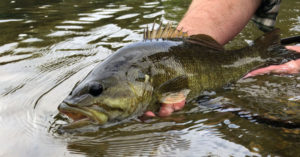June and July Bass at Woodruff Lake
with Sam Russell
Bass fishermen know summertime fishing is tough. As the waters in our lakes gets hotter and hotter the bass get harder to catch. But summertime fishing does not have to mean dawn and twilight or night fishing only. Pick a river lake like Woodruff on the Alabama River and you can work the current and catch bass anytime it is moving.
R.E (Bob) Woodruff Lake, also known as Jones Bluff, is on the Alabama River at Prattville, near Montgomery. The dam backs water in the river up all the way to its headwaters where the Coosa and Tallapoosa join. It is a narrow river lake so any power generation at the dam quickly creates current that puts bass in a feeding mood and positions them on structure and cover the whole length of the lake.
As the uppermost of the Alabama River Lakes, Woodruff is the most river-like lake and winds its way for 80 miles and covers about 12,800 acres. There are 11 Corps of Engineers parks with various facilities like campgrounds and boat ramps as well as several other private and public facilities on the water, so the lake is readily accessible for all of its length. Last year there were over 2 million visitors to Woodruff.
There are some good largemouth in Woodruff but spotted bass will make up most of your catch. In the 2006 Bass Anglers Information Team (BAIT) report there were only seven club tournaments reported on Woodruff but the success rate was good at 69.44 percent. Although there were only two bass reported over five pounds, the average weight was 1.66 pounds, respectable for a lake with a 12 inch limit.
Sam Russell was born in Montgomery and lived all his life in Prattville. He works for the City of Prattville on a seven day on, seven day off shift so he gets lots of fishing time. His father loved bass fishing and fished some local tournaments in the 1970s as well as fishing with some local bass clubs. Sam fished with him and started club fishing, too.
After a break from bass fishing Sam started back to bass tournament fishing about ten years ago. He is currently in the Prattville Bass Anglers club and fishes some local pot and charity tournaments. Last year he fished a BFL as a co-angler and placed 12th in that tournament. He also fished the Federation trail last year and although he didn’t go to the championship tournament, he was in the top ten in point standings up to the championship.
Sam likes the river system lakes and loves to catch spots. His biggest spot from Woodruff was a six pounder that hit a topwater plug. He says he though it was a striper the way it hit and fought but when he finally saw it was a huge spot his knees got weak. He still managed to land that fish. Sam has also caught a seven pound largemouth from Woodruff.
In June and July Sam will fish points at the mouths of creeks, bluff banks with wood and rock cover and blowdown trees in the water. Those three kinds of places are all over the lake and hold fish all summer long. Although you can catch fish from all of them anytime, current will make them all better and mean you catch better quality fish.
On the points Sam will start with a topwater plug like a Zara Spook. After covering the point with it he will throw a Carolina rig or a jig head worm on it. The bluff banks are also hit with topwater then fished with a spinnerbait and a jig head worm. If those patterns fail, or if he is looking for a kicker fish, Sam will flip laydown trees and shady wood cover with a jig and pig or a big worm.
A fellow club member started the W-3 Tackle Company a few years ago and pours custom jig heads. He is one of Sam’s sponsors and Sam really likes the design of the Tip-Up jig head he makes. They are a modified mushroom head with the eye of the hook forward so the jig rolls up as you pull on it, making the trailing worm move with an action the bass love.
Sam fishes a 3/16 ounce jig head with a 5 inch Senko or a Trick worm trailer on 8 pound Fluorocarbon line with a spinning rod on points. He will throw the same jig and worm on 14 pound line on a casting outfit when fishing wood cover. The Gamakatsu and Owner hooks in the W-3 baits are sturdy enough to stand up to a lot of pressure.
A few weeks ago Sam showed me the following 11 spots to fish in June and July. We were a little early for this pattern and we hit a bluebird clear day after a storm front moved though at the end of April but we still caught about 15 keepers in a half day of fishing. All were spots and most hit on the jig head worm, with a couple hitting a Spook.
There was no current the day we fished so most of what we caught was in the one to two pound range, but bigger fish will hit on these spots with current. You can call 334-682-4896 to get the generation schedule at the dam so you can plan your trip when current is moving. Give them a try to see the pattern Sam fishes and you can find similar spots the whole length of the lake.
1. N 32 21.458 – W 86 42.154 – The mouth of House Creek is typical of the kinds of points Sam likes to fish this time of year. There is a sign showing House Creek on the downstream point and the creek mouth has a no-wake buoy in the middle of it.
Start fishing the upstream point, working a topwater lure around the small grassbed there. There is a little cypress tree on the point that is worth a cast and out from it and the grass a small flat extends out then drops off into the river channel. That makes the perfect kind of feeding area to fish.
Work into the mouth of the creek on the upstream side, fishing into the creek about 50 yards then jump across and work out to the downstream point. There are some trees in the water on the downstream side and the point has overhanging trees. Cast under them and around any wood in the water with topwater then run a spinnerbait through them. Follow that up with a jig head worm.
Before you leave jump across the mouth of the creek and work upstream, hitting the docks along this bank. Sam hooked what looked like a good keeper on this point but it pulled off his Spook. If you catch a fish keep working the area, they often stack up on these spots now.
2. N 32 21.273 – W 86 41.480 – A little ways upstream of House Creek on the same side there is a bluff bank that Sam likes. As you head upstream the channel will swing slightly to your left. Watch on your right for a broken off snag tree on the bank and start fishing there. Just past it a fallen tree has pulled its roots away from the bank, leaving a bare dirt bank. Fish that tree in the water.
Work on up this bluff and hit any wood and weeds along the edge. Fish at an angle here, casting upstream and working your bait back. Sam watches his depthfinder and swims his bait back at the depth he sees fish after hitting the bottom near the bank. The bottom drops off fast here. It is important to keep your bait moving with the current so cast upstream as you work along this bluff.
Fish past the steep gray clay bank, hitting the rocks along the edge of the water. If you catch a fish keep working this bank, there should be more along it. If the current is moving fish these places carefully. If there is no current fish faster and cover more water.
3. N 32 21.333 – W 86 40.639 – A little further upstream on the same side past the boat ramp at Holy Ground Battle Park the mouth of Cypress Creek is good. We took several spots off the downstream point, casting a jig head worm out past the log and grass on the point. There are some rocks on the bottom and a few big stumps here the spots like.
As on most of these creek mouth points the current will move baitfish across them and make them better. The current positions the bass on the point so you might have to fish around it some to locate how they relate to it. Since there was no current the day we fished the bass were not as active and we had to work the bait on the bottom on the rocks to get them to hit.
Fish into the creek a short distance then fish the upstream point, too. There is a big shallow flat in the mouth of the creek that bass sometimes run shad up on, so always keep and eye out for schooling fish and have a topwater bait ready to throw to them.
4. N 32 21.823 – W 86 40.222 – Molly Branch is on the other side of the lake and has a good sandbar that runs across the mouth of the creek from the downstream side. The sign for Molly Creek is on the downstream point. This is a real good point to work with topwater. There is also some gravel and a few scattered stumps to hold fish here, so fish it with worms, too. Sam says this is a good Carolina rig hole.
The long tapering sand point runs almost all the way across the mouth of the creek. Concentrate on it rather than the upstream point here. Probe for any irregular features in the point where it makes a little cut or dip. Those are the places the bass will hold. We caught a couple of keepers here when we fished and it should be even better now.
5. N 32 24.220 – W 86 38.115 – Going upriver the mouth of Swift Creek is on your left. The upstream point runs way out across the mouth of the creek and there is a no-wake buoy lying on its side in the mouth of the creek. There is a short no-wake zone at the mouth of the creek.
Fish the upstream point, working all around it. Fish it from the river channel side, casting up to the shallow top of the point, then fish all the way around the end and up the creek side. Cast across the point from several angles probing for anything on the bottom like rock or wood that will hold fish.
6. N 32 23.613 – W 86 36.747 – Going up river watch the left bank for a gap where the underbrush has been cleared. There are four big trees with nothing growing under them and a big dead tree on the downstream edge of this gap. That marks the start of a good bluff to fish. On the upstream end of the bluff is a double ditch entering the river and there is a big log lying on the downstream point of it.
The bluff bank is marked by a high yellow clay bank. Start fishing where the dead oak stands on the bank and fish upstream. This bank gets some shade during the day and is a good example of the kinds of bluffs Sam likes, with a steep drop, wood cover along it and some shade from shoreline trees and overhanging bushes.
Fish topwater in the shade then work a jig head worm or a spinnerbait through any wood cover. When you get to the ditch, fish the log on the point carefully as well as the drop on this downstream point. This is also the kind of bank that is good to flip a jig and pig or Zoom Ole Monster worm to wood cover, especially on bright sunny days.
7. N 32 22.544 – W 86 37.041 – Across the river, on your right going upstream there is a dock with four tall white poles. It marks the start of another good bluff bank to fish. Upstream of it is a steep yellow clay bank just past a ditch that enters the river. Start fishing upsteam of the ditch and work upstream, casting to any shade from overhanging bushes and trees in the water.
Along this bank there is usually a lot of water dripping in. This can help the fishing a little since it is cooler and has more oxygen than the lake water. Bass will move close to the bank under overhanging bushes and take advantage of the inflow. You can take advantage of them by casting under the bushes where they are holding.
8. N 32 22.014 – W 86 36.340 – Upstream on the same side is Tensaw Creek. There are ledge islands on both sides of it and the points on both sides are good. The sign marking Tensaw Creek is on the downstream point. The river channel runs in right by the mouth of the creek, offering good deep water to fish holding here.
Fish the upstream point working into the mouth of the creek. The island that makes the point has some grass on it that is worth a few casts if the water is high. Fish across the channel between the island and the bank. You will see the top of a buoy in the middle of it and there is a ledge that runs across it, dropping into the channel. Fish that drop.
The other side of the channel comes up on what looks like an old roadbed or pond dam. Fish all around it, work the tree lying in the water on the end of it and into the pocket behind it. Then jump across to the other side and work out, hitting both sides of the ditch on that side and out to the main river point.
Jump back across the mouth of the creek and fish the outside bank of the island going upstream. It drops fast and there is some wood cover along it. When you get to the upstream point fish it carefully. There are good rocks here and a big log was lying on the point when we fished it. Sam said he watched Kevin Van Dam fish this spot several times in the Bassmasters Elite Series tournament held here.
9. N 32 21.712 – W 86 35.701 – Just upstream of Tensaw Creek the river makes a bend back to the left and the outside of this bend is a good place to fish. There is a small flat running off the bank for about 20 feet then it drops straight off to 60 feet deep. Wood has washed in along this drop and flat and it holds bass.
Start fishing at the first dock you see on your right just downsteam of where the bend starts and fish up the bank, casting to the bank and working your bait across the flat to the boat. Keep your boat over the channel. Topwater works well here and a spinnerbait fished through the wood will draw strikes, too. Follow up with a Carolina rig or jig head worm.
10. N 32 22.123 – W 86 35.335 – Upstream and across the lake is Bear Creek. There is a sign for it and you will see two big standing snags in the middle of the creek. Just downstream of the creek mouth is a backout with a ridge across the mouth of it from the downstream point.
Start fishing on the point on the backout and work up it, keeping your boat out in the deeper water and casting across the point. Fish to the end of it then cut across to the downstream point of the mouth of Bear Creek. Fish it and the point across from it.
This is a complex creek mouth with several drops and some grass beds wood cover and rocks, too. All can hold fish so spend some time here checking out the different angles and drops. Fish it all before leaving.
11. N 32 20.391 – W 86 35.184 – Run up to the mouth of Tallawassee Creek on your right where the river bends back to the left. There is no sign here, you can see the pole for it on the downstream point, but there is a red striped channel marker on the back side of the point that runs off the downstream point and there are two poles marking stumps on the top of the point. There is a red river channel marker just downstream of this point, too.
As we idled up to this point in the middle of the day Sam said there had been a million bass caught here. We caught three, including one of the biggest of the day, so make that a million and three now.
This point runs way out across the mouth of the creek from the downstream side and there is wood and rock cover all along it. The channel swings right by the point and makes it a ledge coming out of the channel. Fish hold all along the point on top and along the drop.
Keep your boat out in the channel and cast up onto the point, working your jig head worm through the rocks. They are rough and you will get hung up, but you will hang up on fish, too. A topwater bait would work well here, especially early in the morning and as Carolina rig works off the end of the point. Fish it carefully since it is a big, long wide, sloping point.
These 11 spots are some of Sam’s favorites and give you an idea of the kids of places he fishes. There are many more all over the lake. Use his tips and tactics to fish them and learn how to catch fish off them then you can find others to fish.
Sam has decided to do some guiding on the Alabama River lakes like Woodruff and Miller’s Ferry. Call him at 334-301-0922 if you want him to show you first hand how he catches bass on those lakes.
How about a “contacts” box somewhere in the article – if you need more space used up:
Generation Schedule for Woodruff – 334-682-4896
Contact Sam Russell for Guide Trips – 334-301-0922
W-3 Tackle Company – 334–567-8486
Corps of Engineers Office – info and maps – 334-872-9554



